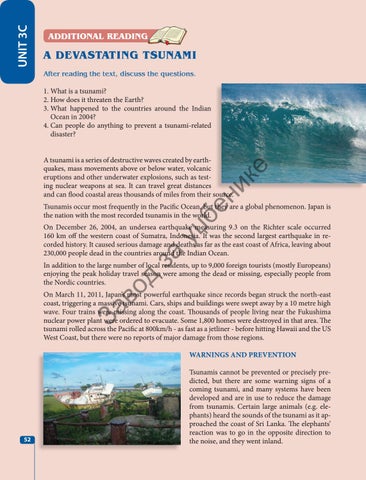UNIT 3C
ADDITIONAL READING
A DEVASTATING TSUNAMI After reading the text, discuss the questions.
1. What is a tsunami? 2. How does it threaten the Earth? 3. What happened to the countries around the Indian Ocean in 2004? 4. Can people do anything to prevent a tsunami-related disaster?
ни ке
A tsunami is a series of destructive waves created by earthquakes, mass movements above or below water, volcanic eruptions and other underwater explosions, such as testing nuclear weapons at sea. It can travel great distances and can flood coastal areas thousands of miles from their source.
уџ бе
Tsunamis occur most frequently in the Pacific Ocean, but they are a global phenomenon. Japan is the nation with the most recorded tsunamis in the world.
за
On December 26, 2004, an undersea earthquake measuring 9.3 on the Richter scale occurred 160 km off the western coast of Sumatra, Indonesia. It was the second largest earthquake in recorded history. It caused serious damage and deaths as far as the east coast of Africa, leaving about 230,000 people dead in the countries around the Indian Ocean.
во
д
In addition to the large number of local residents, up to 9,000 foreign tourists (mostly Europeans) enjoying the peak holiday travel season were among the dead or missing, especially people from the Nordic countries.
За
On March 11, 2011, Japan’s most powerful earthquake since records began struck the north-east coast, triggering a massive tsunami. Cars, ships and buildings were swept away by a 10 metre high wave. Four trains were missing along the coast. Thousands of people living near the Fukushima nuclear power plant were ordered to evacuate. Some 1,800 homes were destroyed in that area. The tsunami rolled across the Pacific at 800km/h - as fast as a jetliner - before hitting Hawaii and the US West Coast, but there were no reports of major damage from those regions. WARNINGS AND PREVENTION
52
Tsunamis cannot be prevented or precisely predicted, but there are some warning signs of a coming tsunami, and many systems have been developed and are in use to reduce the damage from tsunamis. Certain large animals (e.g. elephants) heard the sounds of the tsunami as it approached the coast of Sri Lanka. The elephants’ reaction was to go in the opposite direction to the noise, and they went inland.







































